Apple iPad mini with Retina Display: Reviewed
by Anand Lal Shimpi on November 16, 2013 8:00 AM ESTThe SoC
The iPad mini with Retina Display rounds out the three platforms that use Apple’s A7 SoC. Although both the iPad Air and iPhone 5S use the A7, the mini’s implementation is closer in nature to the iPhone. The iPad mini’s SoC has always used the same package-on-package (PoP) assembly as the iPhone, with DRAM stacked on top of the SoC itself (1GB in this case). The benefit is obviously a reduction in board area, the downsides have to do with cost and thermals. That’s the first similarity between the mini’s A7 and the iPhone’s A7.
The second is one of frequencies. While the iPad Air’s A7 runs its two Cyclone CPU cores at up to 1.4GHz, the SoC in the iPad mini and the iPhone 5S runs at up to 1.3GHz. That might sound like a minor difference, but it’s far more pronounced when you look at what happens to frequency when you’re running heavy workloads.
Once again I turn to a fairly heavy CPU workload to plot performance over time. This is a multithreaded workload, slightly modified from what we used in the iPad Air review, designed to make the CPU cores consume max power. The scale is linear and the workload is the same across all devices, so what you’re effectively looking at is a graph of thermally bound CPU performance over time across all three A7 implementations:
Being the largest device (and the only device with a metal heat spreader and no DRAM stacked on top), the iPad Air obviously maintains the highest frequencies for the duration of the test. The iPhone 5S, with a significant reduction in internal volume (and a PoP SoC) reduces its CPU frequencies early on in order to keep skin temperature down and properly manage thermals. The iPad mini with Retina Display falls between the two, with its performance curve more closely following that of the iPhone 5S.
Although the mini has a similar max operating frequency to the iPhone 5S, it is a faster device thanks to it being less thermally constrained. Similarly, the iPad Air can be much faster than its clock speed would otherwise imply. If you’re wondering why Apple has been so focused on building its own SoCs and CPU architectures, this is the reason why. There’s a fixed amount of power you can dissipate in the form of heat in these mobile devices while still maintaining a good user experience. Performance per watt is the gating metric for success in mobile, and shipping high IPC/low frequency dual-core SoCs at 32/28nm is the best optimization available to a company like Apple today.
As you’d expect, our browser based CPU tests show the mini’s A7 performing in between the iPhone 5S and iPad Air. None of these tests are anywhere near as stressful as our thermal test from above, so we don’t see exaggerated differences in performance between the platforms. For most, I suspect you won’t notice a huge performance difference between the mini and Air. Those who are heavier users (e.g. audio mixing, 3D gaming, etc…), there will be a performance difference between the two iPads.
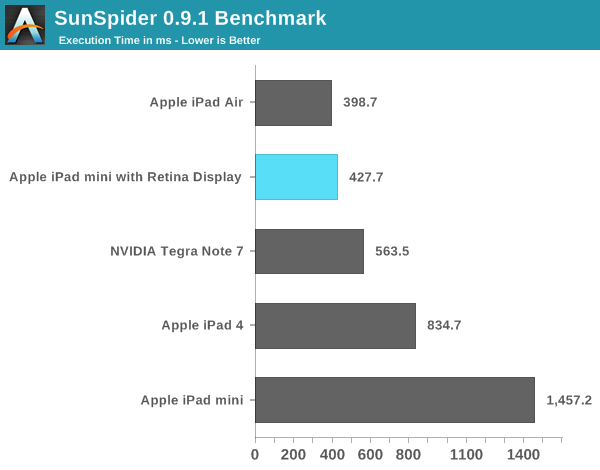

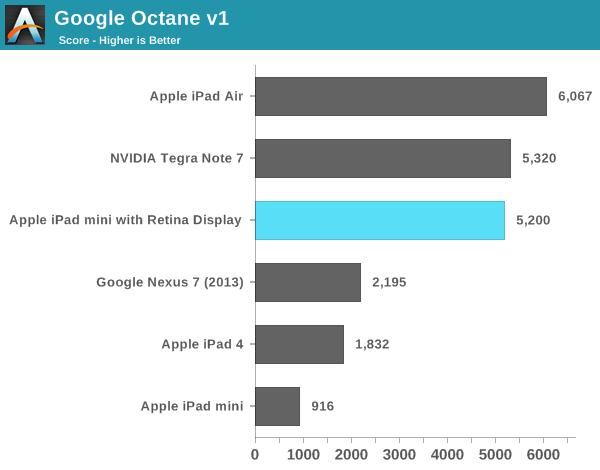
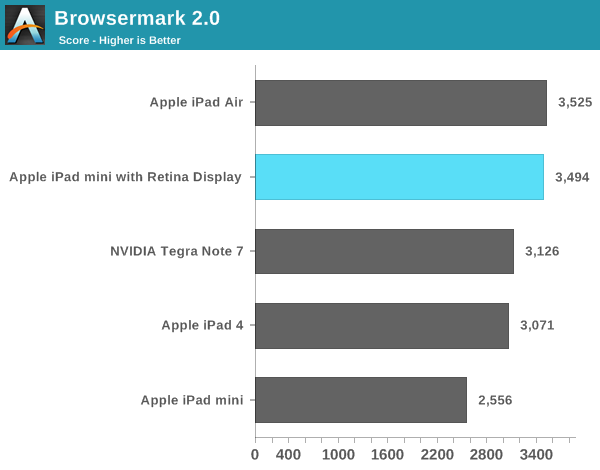
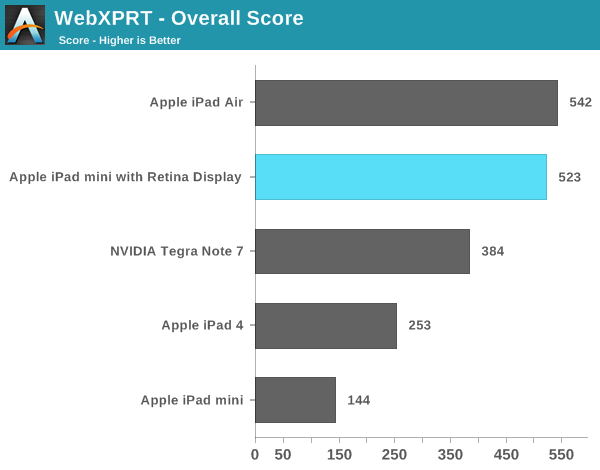
Compared to the first generation iPad mini, the new model is in a completely different performance league. Keep in mind the first mini used Apple’s A5 SoC based on an ARM Cortex A9. That’s the same single threaded performance as what’s in an iPhone 4S, and under iOS 7 it’s clearly running into some performance limits. The new mini with Retina Display however is a completely different animal. It’s fast.
Even comparing to the 4th generation iPad, the new mini is noticeably quicker.
Memory Bandwidth
Looking at the iPad mini’s memory bandwidth curve, we see it tracks very closely with that of the iPhone 5S. This is a slightly modified version of our previous bandwidth test, and you can see peak usable memory bandwidth (from the CPU’s perspective) of around 10GB/s. The ~12GB/s area right before you get out to main memory is bandwidth to the A7’s 4MB system-wide cache that sits after the shared L2 and the memory controller. This cache appears to service CPU, GPU and ISP requests at least.
GPU Performance
I believe the A7’s PowerVR G6430 GPU runs at around 450MHz. This frequency appears unchanged across all three A7 implementations. Once again, the big difference is how much thermal headroom exists in the platform which has an impact on overall performance.
Kishonti’s low level GPU performance tests back up my assertion that GPU frequency is fixed across all A7s. The iPad mini with Retina Display delivers equal performance to the iPad Air. The bigger news here is that nearly all of the GPU bound 3D tests seems to peg the mini and Air as equals. These are some pretty intense tests, but it looks like on the GPU side there’s no significant throttling when running at full tilt.
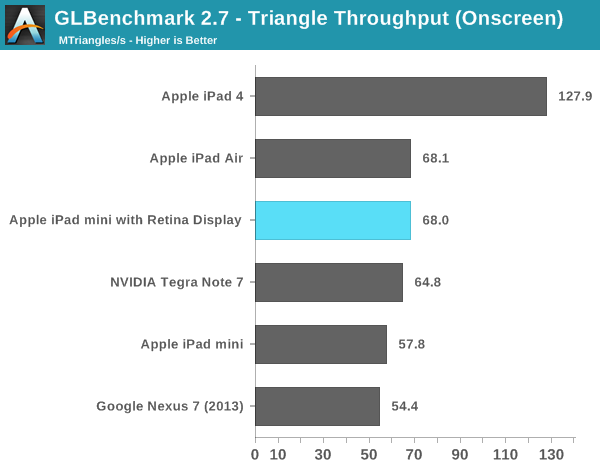

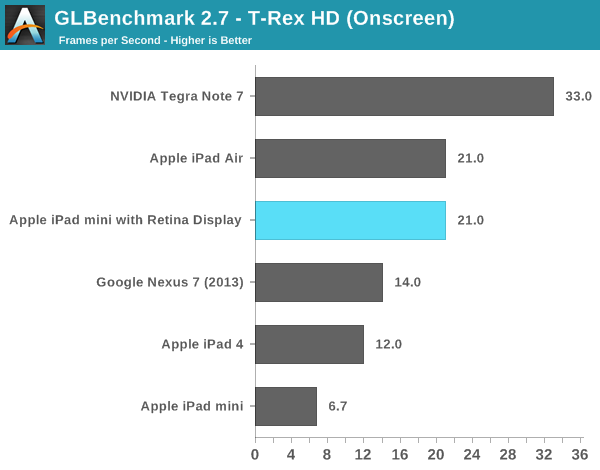

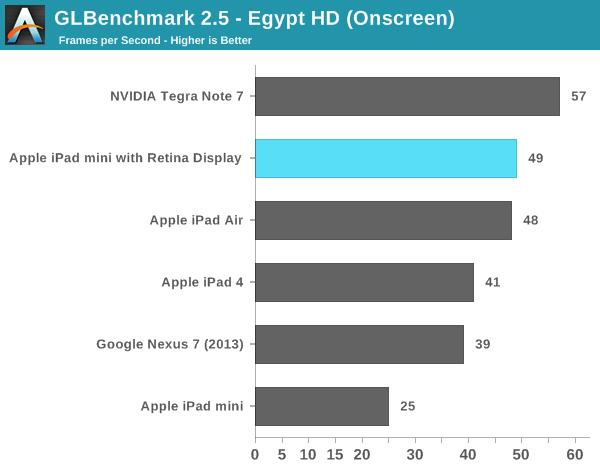
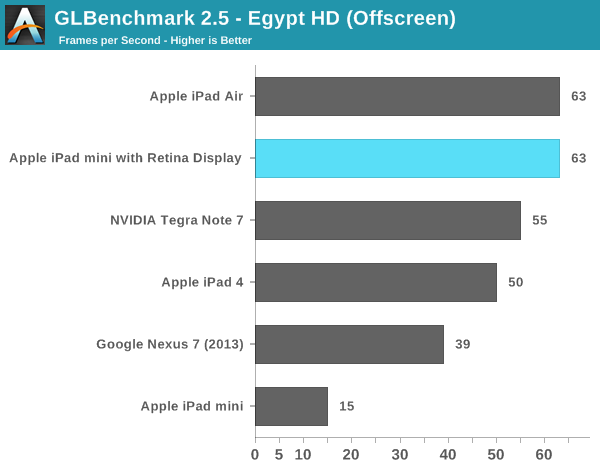
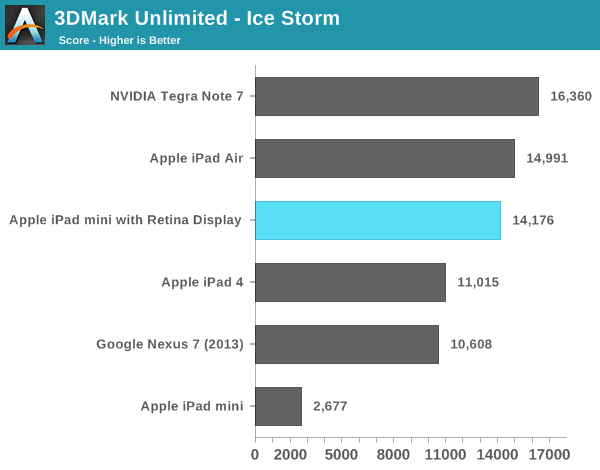
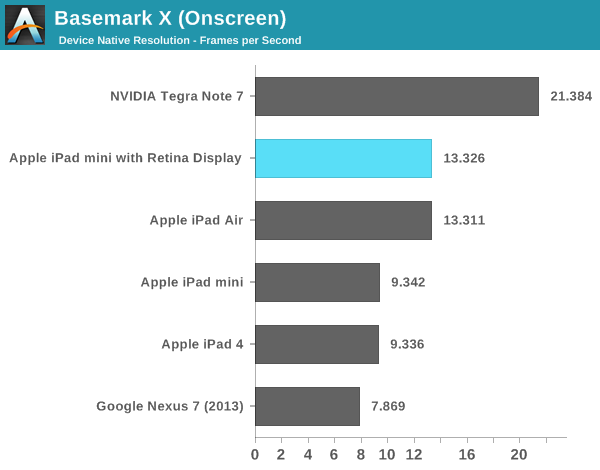
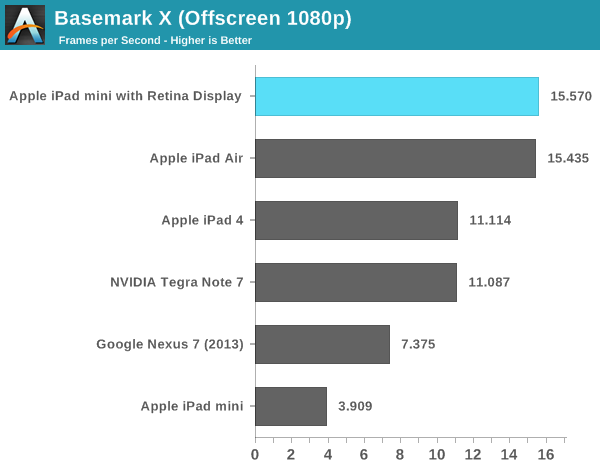
As I mentioned in our iPad Air review, despite having less peak theoretical memory bandwidth than the A5X/A6X, the A7 in the iPad mini never seems to regress in performance compared to even the iPad 4. Across the board the mini appears to be faster, more responsive and have more performance on tap than any prior iPad (big or small). The comparison to the original iPad mini is of course night and day. Even looking at lighter tests like the old GLBench Egypt HD benchmark, the iPad mini with Retina Display manages to be nearly twice as fast as the original mini - all while rendering 4x the number of pixels.


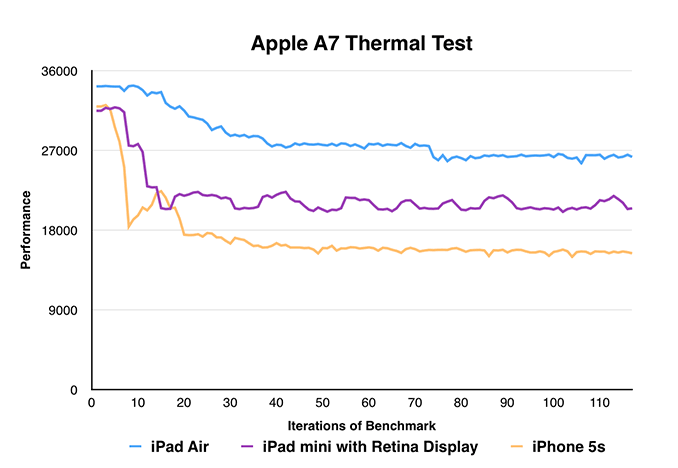
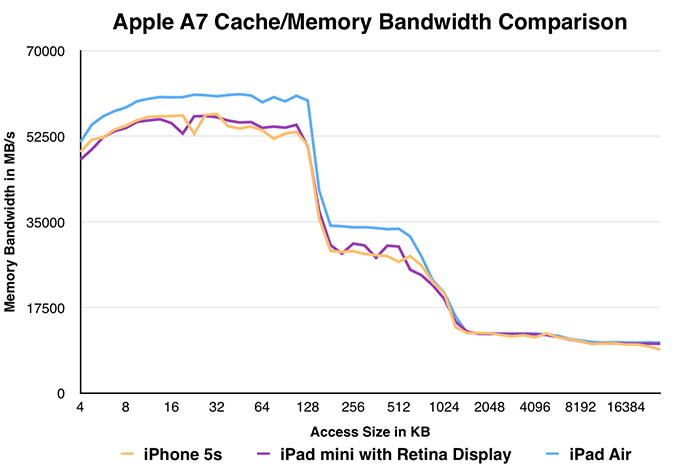








345 Comments
View All Comments
emoemeka - Wednesday, November 20, 2013 - link
And how many of those have ASUS sold? Nobody wants a convertible tablet! People buy tablets because they want tablets. Those who want laptops buy laptops.beggerking@yahoo.com - Wednesday, November 20, 2013 - link
go to slickdeals and search T100. amazon reviews,also surface pro /pro 2
dell venue pros
people buy them to replace both their laptops and tablets.
RadarTheKat - Monday, November 18, 2013 - link
You mentioned the price to buy a new one, but failed to mention the resale price associated with iGadgets. There are always two prices. When both are considered, the value is relatively greater for some products versus others. Please keep this in mind in the future when comparing apple products to their competition.tech4tac - Monday, November 18, 2013 - link
"which *literally* everyone else can see"hmmmm... Must be why Apple had to print an apology.
You keep using that word. I do not think it means what you think it means.
The mini was a reactionary product to counter the growing success of Android 7" tablets--a size which Jobs was adamantly against as he saw the 8.9" form factor as perfect. Both OS developers "borrowed" from each other over the years but the last few iOS versions (i.e. 5, 6, 7) make the two devices look even more similar. Features that appeared on Android prior to iOS (such as notifications bar, control center, and the similar-looking default wallpaper) make the two difficult to distinguish from afar. That said, just buy what works best for you & be done with it.
So calm down & have some Koo-laid. This one's on me.
EarFull - Tuesday, November 19, 2013 - link
Question for those in the know: Would a Firmware or Software update remedy this color gamut issue? I use a lot of Photoshop, Aperture, Lightroom AND associated plug-ins and can change a LOT about a photo digitally. Also, with Spectraview I can change the characteristics of my displays.Thank you
Patrick
JC86 - Tuesday, November 19, 2013 - link
This is just my personal observation/hope but I wouldn't recommend the iPads this generation because they seem like stop-gap iteration refreshes before next year's model that will likely include TouchID sensors throughout the lineup.The TouchID sensors that Apple introduced this year with the the iPhone 5S is clearly where the future of the entire iOS lineup is headed. My guess is that Apple didn't include the TouchID sensor with this generation's iPad lineup because of 1) component costs/supply and more importantly 2) iOS 7 has yet to support multiple user accounts. A feature that I believe will be coming in iOS 8. Since the iPhone is a much more personal device compared to an iPad that is often shared with family members, having TouchID setup with the ability to recognize who just unlocked the iPad and customize the settings and apps accordingly seems like the natural evolution of the TouchID hardware/software integration. Which is why even though my iPad 2 is getting a little old in the tooth, I'm still going to hold out and not upgrade until next year so I don't have significantly obsolete hardware within a few months.
blue meanie - Tuesday, November 19, 2013 - link
Agreed. Between the Touch ID and "retro" color gamut, it looks like I'll hold onto my chunky iPad 3 another year and wait for the iPad mini we all wanted last year. Given the "non-modular" (polite way to put it) nature of tablet manufacturing, key parts really should be of the same, contemporary caliber. I would argue that the display and processor need to be at the top of that list. I would not feel great about a significant investment (LTE and appropriate, yet overpriced, storage) in this iPad if they come out with a proper mini next year.Why is 16GB still an option? $399 should really get one 32GB.
brianlee - Tuesday, November 19, 2013 - link
I'm interested in comparing the sRGB color gamut between screens from Sharp and LG. Since the iPad Mini Retina in this article did not have the artifact issue (marco.org), it must be the display from LG. Does the Sharp display have better colors despite the artifact issue?hummerchine - Tuesday, November 19, 2013 - link
Some of the comments here kill me! There must be some huge Apple haters out there...I fully admit to being the opposite. But man...slagging on Anand? His reviews are far more detailed, thorough, and unbiased than anything out there. He tells what is great...and what isn't...about the new iPad mini with RD.What exactly do you want him to do? The guy is RIGHT ON!
Satyajit - Friday, November 22, 2013 - link
Any clue as to when we can expect a review of the refreshed macbook lineup?